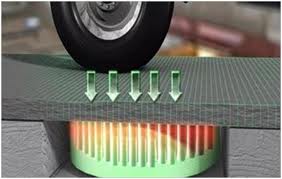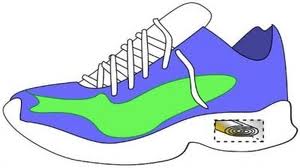
Piezoelectricity is energy produced from pressure. The energy gets generated when an automobile, a truck or a train passes over a surface in which piezoelectric devices are embedded. Even a sidewalk or dance floor can be outfitted with such devices.
The cigarette lighter in an automobile is a good analogy for how piezoelectric devices work. In the case of the lighter a spring-loaded plunger is depressed producing high voltage to heat the embedded element.
Piezoelectric devices are embedded within existing infrastructure. As a result they can work day or night, in almost any climate and in any weather conditions. The energy these devices generate is in some sense serving to recover the energy expended by the vehicles that drive over them. With no footprint on the land like solar and wind, piezoelectric technology can include data collectors making roads smart to monitor and report on traffic conditions, vehicle type and weight, and vehicle velocity. And wherever piezoelectric devices are embedded they are practically impossible to damage or steal.
Innowattech Energy Harvesting Systems is an Israeli engineering firm that has developed the IPEG (TM), the Innowattech Piezo Electric Generator, a device that deforms from the weight of a person, vehicle, train or aircraft as they pass over. IPEGS can be installed in asphalt, concrete or composite material-surfaced roads. The company is working with the Italian government to install IPEGS in a highway running between Venice and Trieste to operate all road lighting.

How much energy can a device like an IPEG produce? A single kilometer (0.62 miles) of roadway with IPEGs installed can generate 400 kilowatts of energy based on average traffic conditions. The busier the road, the more energy it produces. Heavier vehicles means more energy gets generated.
On a personal level imagine owning a pair of shoes with soles that contain piezoelectric technology to power all of your mobile devices from phones to music players to flashlights with every step you take.










Len Says: “How much energy can a device like an IPEG produce? A single kilometer (0.62 miles) of roadway with IPEGs installed can generate 400 kilowatts of energy based on average traffic conditions. The busier the road, the more energy it produces. Heavier vehicles means more energy gets generated.”
The work done to compress the piezo elements must come from the passing vehicles descending slightly when they pass over the elements. But the vehicles must rise again before they can pass over the next element. The power to constantly lift the vehicles’ mass must come from the vehicles’ engines. That is to say burning extra motor fuel. Since automobile engines generally have no better than 25% fuel efficiency, and grid power plants are nearly always above 35% and use cheaper fuel, more fuel that is more expensive would be burned to produce less energy. This is a technically goofy idea.
Not so goofy. Apparently the deformation of road surfaces with piezoelectric devices is no different than road deformation without them according to the device manufacturers. Hence their addition should not contribute to reduced fuel efficiency on the part of vehicles which will expend the fuel in any case. So why not capture kinetic energy this way to use for lighting and toll booths and other lower energy needs? Why not use the captured energy at electric recharge stations when cars stop? If the fuel efficiency of a vehicle is compromised by the devices I fully agree with you.
Len says: “Not so goofy. Apparently the deformation of road surfaces with piezoelectric devices is no different than road deformation without them according to the device manufacturers.”
So the argument is that the piezo element elastic friction losses are approximately the same as present road surfaces, which obviously vary widely? The heavy concrete steel rebar interstate highways are much less flexible than asphaltic state highways. One immediately notices tire road noise is lower on asphalt surfaces than on concrete surfaces. I’ve never seen any studies that contrast fuel mileage between asphalt and concrete highways. In principle, one would expect better fuel mileage on the more rigid surface, but it’s easy to suppose flex in the tires is by so far the dominant factor in rolling resistance that the roadway flex is just a negligible issue.
Everyone “knows” “friction” of steel wheel rail cars rolling on steel rails is lower than deflecting rubber tires rolling on automotive highways. But the vertical deflection of railroad sleepers supported by crushed stone ballast is quite noticeable to the naked eye as loaded rail cars pass over. It would likely take a major research effort to find studies of rail deflection affect on railway fuel efficiency, but the railroad industry is so mature the studies must have been done somewhere back in the age of steam locomotives at least 60-years ago. It would be interesting to see those studies.
Perhaps a good starting point to test the piezo scheme, of which I’m highly skeptical, would be under rail sleepers, preferably in France. Installation of the piezo elements would be much simpler under rail sleepers than under highways. If it works out in France, which has a number of heavily traveled rail routes, I’d be ready to give it a try in the US.
I too believe that railways with visible deformation would be an obvious place to try piezoelectric devices. The deformation on roadways is described in the literature more as vibration than actual visible deformation and that piezoelectric devices in large quantity when placed in a roadbed can contribute enough usable energy to operate highway infrastructure. If the cost of the technology warrants the investment, and the Trieste to Venice project, may give us some really good data, then this is one more technology that could prove to be part of the renewable energy mix.
Len says: “If the cost of the technology warrants the investment, and the Trieste to Venice project, may give us some really good data, then this is one more technology that could prove to be part of the renewable energy mix.”
A couple of decades back I developed an 8″ coaxial dynamic loudspeaker that employed a 1.5” diameter ceramic piezo element tweeter mounted on the magnet structure pole-piece within the voice coil. That allowed near perfect phase and time alignment at the crossover point with sharp roll-offs, both on the woofer and tweeter side. The piezo tweeter drive element itself was developed and produced by Motorola. I invested considerable time studying the literature and consulting with Motorola’s engineers, so I learned a good deal about piezo transducers. At the time, Motorola seemed to have the most advanced piezo technology. The electrical impedance curve of any piezo element will display high impedance at lower frequencies, and the impedance will fall as frequency rises. This is the reverse of a dynamic tweeter (permanent magnet/voicecoil), which will exhibit rising impedance with rising frequency. While very little low frequency audio current will flow through a piezo element, and some people think no crossover is needed to prevent burnout, they are frankly wrong. Sustained 15V will depole a Motorala ceramic piezo element.
It turns out uniform production of piezo ceramic elements is no simple matter. The elements must be electrically polarized while they are fired and cooled. Then in use, over-voltage or over-deflection, regardless of frequency, depolarizes the element and greatly reduces future piezo response. In effect, either over-deflection or over-voltage “burns out” the piezo element. So production is tricky and costly, and in use care must be applied to prevent depolarization.
Motorola had lower cost Asian competition in the piezo transducer business. The Asian elements were less uniform in performance and would depole, and become useless, with much less stress than the Motorola parts. I’m just guessing the roadway mounted piezo element scheme costs and complexities will far exceed the energy benefits.
Still, if the 400 kW figure per km is taken as valid (highly doubtful), and electricity is valued at $0.05 kWh, at peak traffic times that’s $20 per hour. Say the system does that an optimistic average 8-hours per day. $160 times 365-days equals $58,000 annually. What are the costs per km of piezo elements, installation, and maintenance?
If the sensors are on the decline of a hill, no engine power increase required, ‘free’ power.
Regarding costs & durability, technology improves and reduces costs, whereas fossil fuels continually increase.